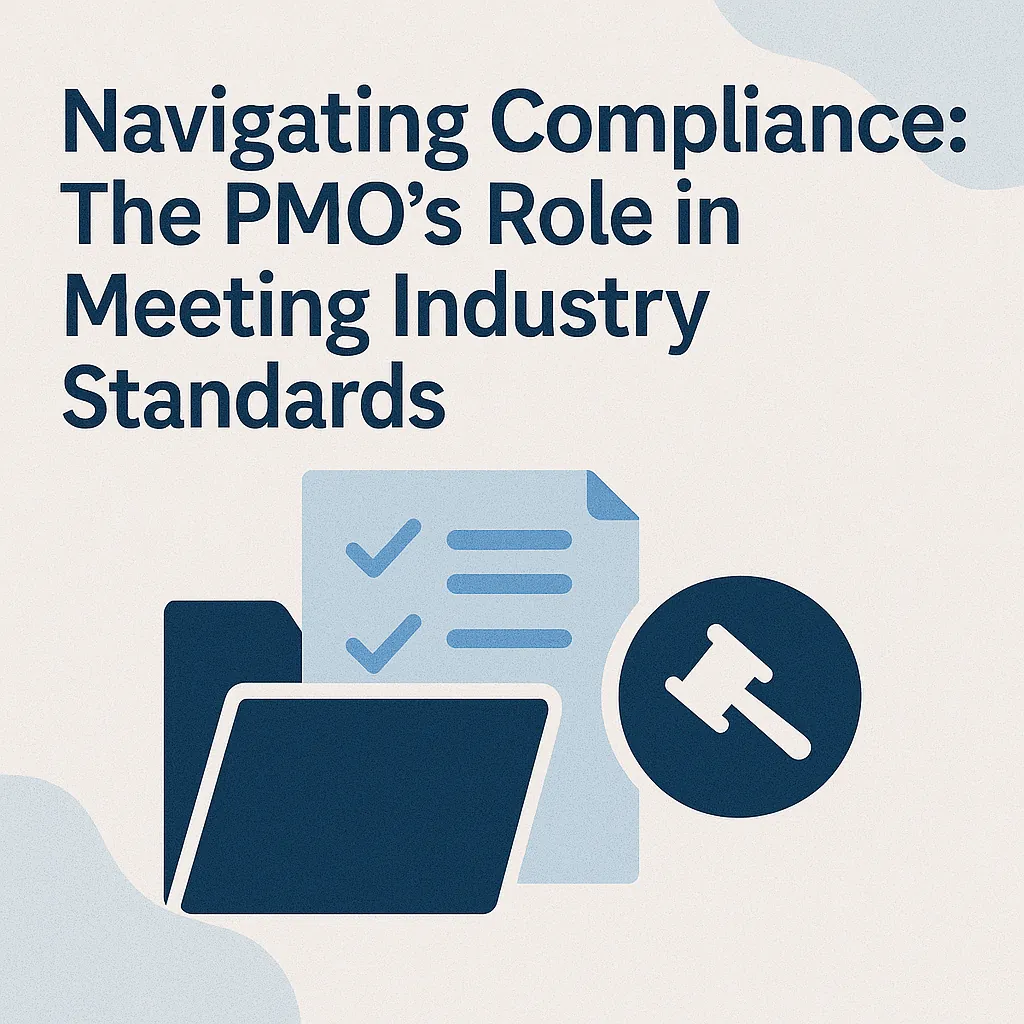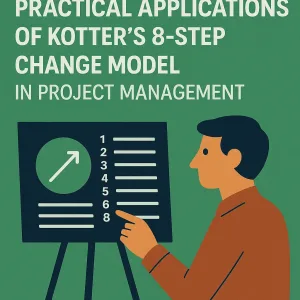Introduction to the PMO and Compliance
The Project Management Office (PMO) serves as a pivotal entity that ensures projects are executed efficiently and effectively while adhering to established standards and regulations. Understanding the PMO’s role is essential for compliance officers and project managers alike, as it directly impacts the success of projects and the organization as a whole.
Defining the Project Management Office (PMO)
The PMO is a centralized unit within an organization responsible for defining, maintaining, and ensuring project management standards across various projects. Its primary functions include:
- Establishing Guidelines and Governance: The PMO sets the framework for project management practices, ensuring that all projects align with the organization’s strategic goals and methodologies, such as Agile or waterfall [2][3].
- Providing Support and Resources: It offers project managers the necessary tools, templates, and processes to facilitate project execution, thereby increasing the likelihood of project success [4][10].
- Centralizing Information: The PMO plays a crucial role in gathering and disseminating project-related information, which is vital for informed decision-making and stakeholder communication [3][13].
Understanding Compliance in Project Management
Compliance in project management refers to the adherence to industry standards, regulations, and internal policies that govern project execution. This encompasses a wide range of requirements, including:
- Regulatory Standards: Organizations must comply with laws and regulations relevant to their industry, which can vary significantly across sectors. This compliance is essential to avoid legal repercussions and maintain operational integrity.
- Quality Assurance: Compliance also involves meeting quality standards that ensure deliverables meet the expected criteria, thereby enhancing customer satisfaction and trust [11].
The Significance of Adhering to Industry Standards and Regulations
Adhering to industry standards and regulations is not merely a legal obligation; it is a strategic imperative that can significantly influence an organization’s reputation and operational success. Key reasons for prioritizing compliance include:
- Risk Mitigation: By following established guidelines, organizations can minimize risks associated with project failures, legal issues, and financial penalties [9][12].
- Enhanced Credibility: Compliance with recognized standards enhances an organization’s credibility and can be a competitive advantage in the marketplace, as clients and stakeholders often prefer to work with compliant entities [12].
- Improved Project Outcomes: Projects that adhere to compliance standards are more likely to be completed on time, within budget, and to the desired quality, ultimately contributing to the organization’s overall success [13][15].
The PMO plays a critical role in navigating the complex landscape of compliance in project management. By establishing standards, providing support, and ensuring adherence to regulations, the PMO not only facilitates project success but also safeguards the organization’s integrity and reputation in the industry.
Understanding the Regulatory Landscape
Compliance with industry regulations and standards is paramount. The Project Management Office (PMO) plays a crucial role in navigating this complex landscape, ensuring that projects adhere to the necessary legal and regulatory frameworks. Below are key points that outline the various regulations and standards impacting project management across different industries.
Key Regulations Relevant to Project Management
- ISO Standards: The International Organization for Standardization (ISO) provides a set of standards that guide project management practices. For instance, ISO 21500 offers guidance on project management concepts and processes, which can help organizations align their projects with international best practices [5].
- General Data Protection Regulation (GDPR): This regulation is particularly relevant for projects involving personal data within the European Union. Compliance with GDPR requires project managers to implement stringent data protection measures, affecting project planning and execution [5].
- Project Management Institute (PMI) Standards: The PMI’s Project Management Body of Knowledge (PMBOK® Guide) outlines best practices and methodologies that project managers should follow to ensure compliance with industry standards [5].
Implications of Non-Compliance and Potential Risks
Non-compliance with regulatory standards can lead to significant repercussions for organizations, including:
- Legal Penalties: Organizations may face fines or legal action if they fail to comply with regulations such as GDPR or industry-specific standards [9].
- Reputational Damage: Non-compliance can harm an organization’s reputation, leading to a loss of trust among stakeholders and clients [9].
- Project Delays: Compliance issues often necessitate additional time for legal reviews and adjustments, which can delay project timelines and increase costs [9].
Industry-Specific Compliance Requirements
Different industries have unique compliance requirements that project managers must navigate:
- Healthcare: In the healthcare sector, compliance with regulations such as the Health Insurance Portability and Accountability Act (HIPAA) is critical. Project managers must ensure that projects involving patient data adhere to strict privacy and security standards [2].
- Finance: The financial industry is governed by regulations such as the Sarbanes-Oxley Act, which mandates strict financial reporting and auditing standards. Project managers in this sector must ensure that their projects comply with these regulations to avoid legal repercussions [2].
- Construction: Compliance with safety regulations and building codes is essential in construction projects. Project managers must be aware of local and national regulations to ensure that projects meet safety standards [2].
Understanding the regulatory landscape is vital for project managers and compliance officers. The PMO’s role in ensuring adherence to these regulations not only mitigates risks but also enhances the overall success of projects across various industries. By staying informed about key regulations and their implications, organizations can navigate compliance challenges effectively and maintain their competitive edge.
The PMO’s Compliance Responsibilities
The Project Management Office (PMO) plays a pivotal role in ensuring that projects adhere to industry standards and regulatory requirements. This section delves into the specific responsibilities of the PMO in fostering compliance, which is crucial for both compliance officers and project managers.
Governance Body for Compliance
The PMO serves as a governance body that establishes and monitors compliance standards across all projects within an organization. It is responsible for defining the project management methodology that teams utilize, which can include frameworks such as Agile, waterfall, and PMBOK. By centralizing information and delivering it to relevant stakeholders, the PMO ensures that all projects align with organizational strategy and comply with regulatory requirements [1][8]. This governance framework encompasses rules and regulations that govern all aspects of project execution, thereby promoting consistency and accountability [2][9].
Developing Compliance Frameworks and Policies
One of the core responsibilities of the PMO is to develop and maintain compliance frameworks and policies that guide project execution. This involves creating specific templates, forms, and tools that project teams must adhere to, ensuring that all projects conform to established governance practices [7][11]. The PMO’s role in this area is critical, as it not only establishes the standards but also ensures that they are effectively communicated and understood by all project stakeholders. By doing so, the PMO helps mitigate risks associated with non-compliance and enhances the overall quality of project management within the organization [4][10].
Facilitating Training and Awareness
To ensure that project teams are well-equipped to meet compliance standards, the PMO also plays a vital role in facilitating training and awareness initiatives. This includes providing guidance, mentorship, and supervision to project managers and teams, helping them understand the importance of compliance and how to implement it effectively in their projects [4][10]. By conducting training sessions and workshops, the PMO fosters a culture of compliance within the organization, empowering project teams to recognize and address compliance issues proactively [3][14].
The PMO’s responsibilities in compliance are multifaceted, encompassing governance, framework development, and training. By fulfilling these roles, the PMO not only ensures adherence to industry standards but also enhances the overall effectiveness of project management practices within the organization.
Integrating Compliance into Project Management Processes
The integration of compliance into every phase of the project lifecycle is essential for ensuring that projects not only meet industry standards but also mitigate risks effectively. This section outlines strategies for embedding compliance into project planning and execution, emphasizing the importance of risk management and providing examples of tools and techniques for monitoring compliance.
Incorporating Compliance Checks in Project Planning and Execution
To effectively incorporate compliance checks into project management, it is crucial to establish a compliance framework that aligns with the project’s objectives. Here are some strategies to consider:
- Define Compliance Requirements Early: At the outset of the project, identify all relevant laws, regulations, and industry standards that apply. This proactive approach ensures that compliance is not an afterthought but a foundational element of the project plan [1].
- Integrate Compliance into Project Milestones: Embed compliance checks at key milestones throughout the project lifecycle. This could involve scheduled reviews or audits to assess adherence to compliance standards, ensuring that any issues are addressed promptly [2].
- Develop a Compliance Checklist: Create a comprehensive checklist that outlines all compliance requirements specific to the project. This tool can serve as a guide for project managers and teams to ensure that all necessary compliance measures are being followed during execution [10].
Importance of Risk Management in Compliance
Risk management plays a pivotal role in compliance, as it helps identify potential compliance-related risks and develop strategies to mitigate them. Here are some key points to consider:
- Risk Assessment: Conduct regular risk assessments to identify areas where compliance may be at risk. This involves evaluating both internal processes and external factors that could impact compliance [5].
- Mitigation Strategies: Develop and implement mitigation strategies for identified risks. This could include training for team members on compliance issues, establishing clear communication channels for reporting compliance concerns, and creating contingency plans for potential compliance failures [6].
- Continuous Monitoring: Establish a system for continuous monitoring of compliance risks throughout the project lifecycle. This ensures that any emerging risks are identified and addressed in a timely manner, thereby enhancing overall project success [4].
Tools and Techniques for Monitoring Compliance
Utilizing the right tools and techniques is essential for effective compliance monitoring throughout the project lifecycle. Here are some examples:
- Project Management Software: Integrating compliance and inspection tools into project management software can streamline processes and ensure that projects meet legal and quality standards. This integration enhances productivity while reducing risk [2].
- Compliance Dashboards: Implement compliance dashboards that provide real-time visibility into compliance status across various project components. These dashboards can help project managers quickly identify areas that require attention [10].
- Regular Audits and Reviews: Schedule regular audits and reviews to assess compliance with established standards. This not only helps in identifying non-compliance issues but also reinforces a culture of accountability within the project team [8].
By embedding compliance into project management processes, organizations can navigate the complex regulatory landscape more effectively. This approach not only enhances stakeholder satisfaction but also significantly increases the chances of project success while minimizing associated risks [5].
Case Studies: Successful PMO Compliance Initiatives
The Project Management Office (PMO) plays a pivotal role in ensuring that organizations adhere to industry standards and regulatory requirements. This section presents real-world case studies that illustrate how PMOs have successfully navigated compliance challenges, the strategies they employed, and the outcomes achieved.
Case Study 1: Water Utility Client in the Middle East
- Overview: A PMO was established for a water utility client facing significant compliance issues related to environmental regulations.
- Strategies Employed:
- Transitioned from manual project tracking to an automated, data-driven PMO framework, enhancing visibility and accountability.
- Implemented rigorous compliance checks at each project phase, ensuring adherence to local and international standards.
- Outcomes:
- The PMO significantly reduced compliance-related delays, leading to a 30% increase in project delivery speed.
- Enhanced stakeholder confidence, resulting in improved relationships with regulatory bodies.
- Lessons Learned: The importance of integrating compliance into the project lifecycle from the outset cannot be overstated. Early identification of regulatory requirements can mitigate risks and streamline project execution [7][9].
Case Study 2: PMO Revamp for a Manufacturing Firm
- Overview: A manufacturing firm undertook a PMO revamp to address compliance failures that had led to costly penalties.
- Strategies Employed:
- Conducted a comprehensive assessment of existing processes and identified gaps in compliance management.
- Developed a robust governance framework that included regular audits and compliance training for project teams.
- Outcomes:
- The revamped PMO achieved a 50% reduction in compliance violations within the first year.
- The organization regained its reputation and trust with clients and regulatory agencies.
- Lessons Learned: Continuous improvement and training are essential for maintaining compliance. A proactive approach to compliance management fosters a culture of accountability within project teams [5][14].
Case Study 3: Financial Services PMO Implementation
- Overview: A financial services company established a PMO to enhance compliance with evolving financial regulations.
- Strategies Employed:
- Leveraged technology to automate compliance reporting and monitoring, ensuring real-time visibility into compliance status.
- Fostered collaboration between the PMO and compliance officers to align project goals with regulatory requirements.
- Outcomes:
- The PMO’s initiatives led to a 40% improvement in compliance reporting accuracy.
- The organization successfully passed multiple regulatory audits without any findings.
- Lessons Learned: Collaboration between the PMO and compliance teams is crucial. By aligning project objectives with compliance requirements, organizations can achieve both operational efficiency and regulatory adherence [8][12].
These case studies highlight the critical role of PMOs in navigating compliance challenges across various industries. By employing strategic approaches, leveraging technology, and fostering collaboration, PMOs can not only ensure compliance but also drive organizational success. The lessons learned from these initiatives serve as valuable insights for compliance officers and project managers aiming to enhance their compliance efforts.
Challenges Facing PMOs in Compliance Management
The Project Management Office (PMO) plays a crucial role in ensuring that projects align with industry standards and regulatory requirements. However, PMOs often encounter several challenges that can hinder effective compliance management. Below are some of the key barriers, the impact of changing regulations, and strategies to overcome these challenges.
Barriers to Effective Compliance Management
- Lack of Resources: Many PMOs struggle with insufficient resources, which can include both financial and human capital. This scarcity can lead to inadequate compliance monitoring and enforcement, making it difficult to adhere to industry standards [10].
- Knowledge Gaps: Compliance management requires a deep understanding of relevant regulations and standards. PMOs may face challenges due to a lack of expertise among team members, resulting in misinterpretation of compliance requirements and potential non-compliance [10][11].
- Poor Communication: Effective compliance management relies heavily on clear communication within the organization. A lack of communication can lead to misunderstandings regarding compliance responsibilities and expectations, further complicating adherence to regulations [11].
Impact of Changing Regulations on PMO Operations
- Increased Complexity: The regulatory landscape is constantly evolving, with new laws and standards emerging regularly. This dynamic environment can create confusion and increase the complexity of compliance management for PMOs, as they must continuously adapt their processes to meet new requirements [5][10].
- Resource Allocation Challenges: As regulations change, PMOs may need to reallocate resources to address new compliance demands. This can strain existing projects and lead to delays or reduced effectiveness in project delivery [10].
- Risk of Non-Compliance: Failing to keep up with changing regulations can expose organizations to significant risks, including legal penalties and reputational damage. PMOs must remain vigilant and proactive in their compliance efforts to mitigate these risks [6][10].
Strategies for Overcoming Compliance Challenges
- Invest in Training and Development: To address knowledge gaps, PMOs should prioritize training programs that enhance team members’ understanding of compliance requirements. This investment can empower staff to navigate the regulatory landscape more effectively [10][11].
- Enhance Communication Channels: Establishing clear communication channels within the organization can facilitate better understanding of compliance responsibilities. Regular updates and training sessions can help ensure that all team members are informed about compliance expectations [11].
- Leverage Technology: Utilizing compliance management software can streamline processes and improve tracking of regulatory changes. Technology can also enhance transparency and accountability within the PMO, making it easier to manage compliance effectively [5][10].
- Foster a Culture of Compliance: Encouraging a culture that prioritizes compliance at all levels of the organization can lead to more effective management. This includes promoting awareness of compliance issues and integrating compliance considerations into project planning and execution [10][11].
While PMOs face significant challenges in compliance management, understanding these barriers and implementing effective strategies can enhance their ability to navigate the regulatory landscape successfully. By investing in resources, fostering communication, and leveraging technology, PMOs can play a pivotal role in ensuring compliance and driving project success.
Future Trends in PMO and Compliance
As organizations navigate an increasingly complex regulatory landscape, the role of the Project Management Office (PMO) in ensuring compliance is evolving significantly. Here are some key trends that highlight the future of PMOs in compliance management:
Impact of Technology on Compliance Management
- Automation and AI Integration: The integration of automation and artificial intelligence (AI) is transforming compliance management. These technologies streamline processes, reduce human error, and enhance data analysis capabilities. By automating routine compliance tasks, PMOs can focus on strategic oversight and decision-making, ensuring that compliance measures are not only met but also optimized for efficiency [4][11].
- Data Analytics for Compliance Monitoring: The rise of data analytics tools allows PMOs to monitor compliance in real-time. By leveraging data, PMOs can identify potential compliance risks early and implement corrective actions swiftly. This proactive approach is essential in a regulatory environment where the stakes are high and the consequences of non-compliance can be severe [9][12].
Future Role of PMOs in Regulatory Environments
- Strategic Alignment with Business Objectives: The PMO’s role is shifting from a tactical focus to a more strategic one. High-performing PMOs are expected to align compliance initiatives with broader business objectives, ensuring that compliance is not viewed as a standalone function but as an integral part of the organization’s success [3][15]. This alignment will require PMOs to communicate effectively with stakeholders and demonstrate the value of compliance efforts in achieving business goals.
- Adapting to Regulatory Changes: As regulations continue to evolve, PMOs must be agile and adaptable. This means not only staying informed about changes in the regulatory landscape but also being prepared to adjust compliance strategies accordingly. The ability to pivot quickly in response to new regulations will be a critical success factor for PMOs in the future [2][6].
Importance of Adaptability and Continuous Improvement
- Emphasis on Continuous Improvement: The future of compliance management will require PMOs to adopt a mindset of continuous improvement. This involves regularly reviewing and refining compliance processes to enhance effectiveness and efficiency. By fostering a culture of continuous improvement, PMOs can ensure that compliance practices remain relevant and effective in the face of changing regulations and business environments [1][12].
- Collaboration and Knowledge Sharing: PMOs will increasingly need to collaborate with compliance officers and other stakeholders to share knowledge and best practices. This collaborative approach will help organizations build a more robust compliance framework that can withstand regulatory scrutiny and adapt to new challenges [8][14].
The PMO’s role in compliance is set to expand and evolve in response to technological advancements and changing regulatory requirements. By embracing these trends, PMOs can position themselves as strategic partners in compliance management, driving organizational success while navigating the complexities of the regulatory landscape.
Conclusion
In the complex landscape of project management, the Project Management Office (PMO) plays a crucial role in ensuring compliance with industry standards and regulations. As organizations face increasing scrutiny regarding their adherence to compliance requirements, the PMO emerges as a pivotal entity that not only enforces project management processes but also safeguards the integrity and success of projects.
Key takeaways include:
- Vital Role of the PMO: The PMO is essential in navigating compliance by establishing governance structures, defining project management methodologies, and ensuring that all projects align with regulatory requirements. This centralized oversight helps mitigate compliance risks and enhances project outcomes, making the PMO a cornerstone of effective project governance [1][9][10].
- Collaboration is Key: For compliance officers and project managers, fostering a collaborative relationship is imperative. By working closely together, they can ensure that compliance considerations are integrated into every phase of project management. This partnership not only streamlines processes but also enhances communication and accountability, ultimately leading to more successful project delivery [4][8].
- Actionable Next Steps: To enhance compliance within your organization, consider the following steps:
- Define Compliance Requirements: Clearly outline the compliance requirements relevant to your projects, including security, health and safety, and regulatory standards [6][7].
- Establish a Compliance Framework: Develop a structured framework that integrates compliance into project planning and execution, ensuring that all team members are aware of their responsibilities [2][3].
- Regular Training and Updates: Implement ongoing training programs for project teams to keep them informed about the latest compliance regulations and best practices [5][12].
By taking these proactive measures, compliance officers and project managers can significantly improve their organization’s ability to meet industry standards and navigate the regulatory landscape effectively. Embrace the PMO’s role in compliance management and work together to foster a culture of accountability and excellence in project execution.
Find out more about Shaun Stoltz https://www.shaunstoltz.com/about/.
This post was written by an AI and reviewed/edited by a human.



